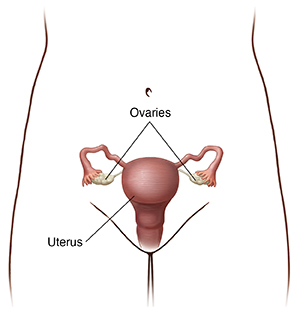Understanding Primary Ovarian Insufficiency (POI)
Primary ovarian insufficiency (POI) is when the ovaries stop working normally before the age of 40. An ovary does not release an egg each month as it should. This can cause symptoms and make it much less likely to get pregnant.
How POI affects the ovaries
The ovaries are a pair of small, oval-shaped organs in the lower part of a person’s belly (abdomen). About once a month, one of the ovaries releases an egg. The ovaries also make the hormones estrogen and progesterone. These play roles in pregnancy, the menstrual cycle, and breast growth. A person with POI may have fewer eggs. Or the ovaries may not release eggs correctly. The ovaries do not make the normal amounts of hormones. This leads to the symptoms of POI.

POI is not menopause
POI has been called premature ovarian failure and premature menopause. But these terms are not as accurate. A person with POI may still have some function of their ovaries. POI is not the same thing as menopause. Menopause normally happens around age 50. In the transition time before menopause, the ovaries make smaller amounts of hormones. This time is called perimenopause. At the time of menopause, the ovaries run out of eggs. The menstrual cycles stop. Those with POI may have irregular or even normal menstrual cycles. They may still have eggs in their ovaries.
What causes POI?
Researchers are still learning about the causes of POI. It can result from any cause that reduces the number of eggs in the ovaries. It can also happen if your ovaries don’t make enough hormones. This can happen even with a normal number of eggs.
Some of the known causes of POI include:
-
Genetic conditions, such as Turner syndrome, Fragile X syndrome, or galactosemia
-
Toxins that affect the ovaries, such as from radiation or chemotherapy
-
Infections that damage the ovaries, such as mumps
-
Surgery on the ovaries
-
Autoimmune diseases
-
Problems with hormones that regulate the ovaries, such as follicle-stimulating hormone (FSH)
-
Thyroid disease
-
Eating disorders
In most cases, the cause of the condition isn’t known.
Symptoms of POI
Most people with POI have had a normal puberty and normal periods. You may first notice your periods don’t start up again after a pregnancy. Or you may be having irregular periods. Many people have irregular periods for years before being diagnosed.
Some with POI have regular periods and no symptoms of POI. Some may have symptoms that come and go. Symptoms can include:
-
Irregular periods
-
No periods
-
Inability to get pregnant
-
Less sex drive
-
Painful sex because of thinning and drying of the vagina
-
Hot flashes and night sweats
-
Irritability
These are many of the same symptoms of normal menopause.
Diagnosing POI
Your healthcare provider will ask about your health history and your symptoms. You will also have a physical exam. This will likely include a pelvic exam. Your blood may be tested for FSH. FSH is higher in those in menopause who are no longer releasing eggs. FSH is also higher in those with POI. This test may be enough for your healthcare provider to diagnose you.
Many health conditions other than POI can cause irregular periods. You may have tests to rule out other causes of your symptoms. These tests may include:
-
A pregnancy test
-
Blood test for prolactin and thyroid levels, other hormones that can cause POI symptoms
-
Adrenal autoantibodies to check for an autoimmune disease
-
Genetic testing to check for genetic conditions
-
Bone density testing to check for osteoporosis caused by low estrogen
Online Medical Reviewer:
Donna Freeborn PhD CNM FNP
Online Medical Reviewer:
Heather M Trevino BSN RNC
Online Medical Reviewer:
Howard Goodman MD
Date Last Reviewed:
12/1/2022
© 2000-2024 The StayWell Company, LLC. All rights reserved. This information is not intended as a substitute for professional medical care. Always follow your healthcare professional's instructions.